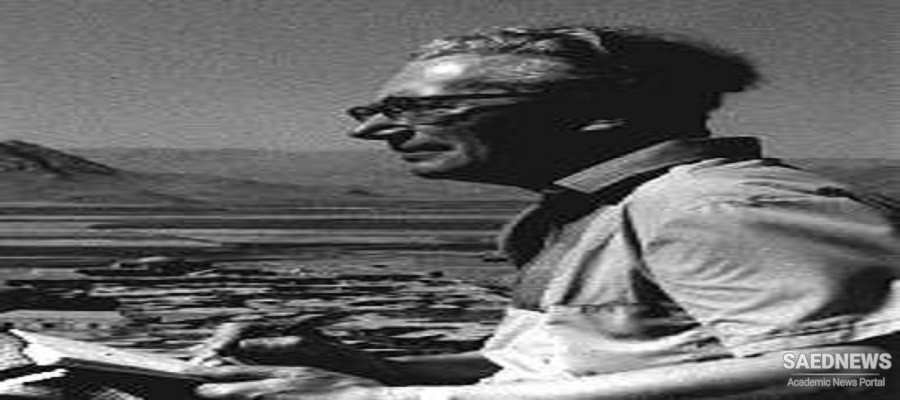Already at an early stage, he devoted himself to problems concerning the archaeology and history of art of the ancient Near East and Iran. He published two article on Greco-Persian art in 1938 (“Achämenidisch-persische Toreutik,” Archäologischer Anzeiger 1938, pp. 759-72, and “Griechisch-persische Metallarbeiten im Antiquariu,” Berliner Museen 59, 1938, pp. 76-80), and in his doctoral dissertation (Die Phiale, 1938) he assembled considerable data on the forms and artistic details of shallow bowls of ancient Greece and Near East. The work was soon published (Bleicherode a. Harz, 1939) and brought its author wide spread acclaim (see the reviews by K. Schefold in Gnomon 17, 1941, pp. 125ff.; H. Dohan, AJA 45, 1941, pp. 127-29), and Luschey received an invitation by a prestigious encyclopeadia of classical antiquity to contribute the entry on the same subject (“Phiale,” Pawly-Wissowa, Suppl. Bd VII, 1940, cols. 1026-30).
After his military service during the Second World War, Luschey worked as an assistant at the Archaeological Seminar of the University of Tübingen. In 1956 he became assistant director of the Istanbul branch of the German Archaeological Institute, and succeeded in supplying the large frieze of the Pergamon altar with a head located in the Archaeological Museum of in Istanbul. In 1960, the construction of a Teheran branch (Abteilung Tehran)) of the German Archaeological Institute started, and Hans Henning von der Osten was chosen to direct it. But he passed away suddenly and Heinz Luschey was appointed in 1961 by the Central Administration of the German Archaeological Institute as the First Director of the Tehran branch. He made great contributions to the establishing of the department and especially of its library, and served devotedly and with personal commitment. When in 1971 he chose early retirement due to health problems, he left his successors with a perfectly functioning institute.
At the beginning of his activity in Iran, he observed that the lion of Hamadan, which had been badly damaged and worn down throughout the centuries, was not a Median or Achaemenid relic, as was usually supposed, but a thoroughly Hellenistic monument, which belonged stylistically to the group of classical Greek lion monuments and probably erected by Alexander the Great to the memory of his friend and general Hephaestion (see “Der Löwe von Eckbatana, “ AMI NF, 1, 1968, pp. 115-22 with Plates 45-50). He also began to work the Iranian Archaeological Service (Edāre-ye koll-e bāstānšenāsi-ye Irān), carrying out surveys in the environmental of Kermanshah and Bisotun, which led to several excavation campaigns in Bisotun from 1963 to 1967. Inspired by Ernst Herzfeld’s Am Tor von Asien, Luschey searched for the “paradise of the Ḵosrows” at the “Gate of Asia.” He was convinced that in Bisotun, in a topographically very distinctive place, where cultural remains form five millennia were preserved in an unbroken sequence, a palace of the Sasanian Ḵosrow II was to be expected, and that the Sasanian stone capitals from Ṭāq-e Bostān might have belonged to that very structure. Luschey and his colleagues established proof of the remains of an Elamite fortress, explored the pre-Achaemind ruins under the rock relief with Darius’s inscriptions, studied the Parthian reliefs situated there and that of Heracles; they dug up a vast Sasanian construction, a game preserve in the thicket of the river bank with the ruins of a Sasanian bridge, measured the gigantic unfinished Sasanian rock-cut bay called Farhād Terāš on the steep face of the Bisotun mountain and carried out excavations on an early Islamic rabāt, which was built from reused Sasanian ashlars, as well as excavating an Il-khanid palace complex. Finally, they also measured the Safavid Bridge and the Safavid caravanserai from the end of the 17th cent. CE.
The results of all these investigation were published by Heinz Luschey and his colleagues in various scientific journals and appeared after His death in 1996 as a summary in the Bisotun publication (Kleiss and Calmeyer, 1996). Luschey’s great merit consisted of providing a clear sequence of Iranian history at the Bisotun site on the basis of the results of these investigations. It was also to his credit that he was instrumental in restarting in 1968 the important series Archaeologische Mittelungen aus Iran, which Ernest Herzfeld had originated in 1929 and continued to produce, almost single handedly, till 1938. For this reason, the first eight volumes of the new series were marked Neue Folge.
Throughout the ten years of his scientific work in Iran, the study of the Achaemenid reliefs of Persepolis was a particular concern of his. Together with his wife, the art historian Dr. Ingeborg Luschey-Schmeisser, he studied Islamic art, especially tiles and ceramics, on the basis of the findings of an Il-khanid palace in Bisotun.
They both continued these studies in Tübingen, where Heinz Luschey settled after his retirement in 1971. And he worked on his unpublished postdoctoral thesis Rechts und Links, Untersuchungen über Bewegungsrichtung, Seitenordnung und Höhenordnung als Elemente der antiken Bildsprache, which saw the light of publication through the effort of his wife Ingeborg Luschey-Schmeisser ten years after his death. (Tübingen, 2002).
Through his comparative studies in classical archaeology, Heinz Luschey has carried out great achievements, and his studies in Iran have considerably contributed to elucidating the history of the land of the Achaemenids.


 GEORG FRIEDRICH GROTEFEND
GEORG FRIEDRICH GROTEFEND














































